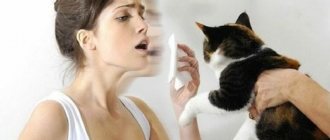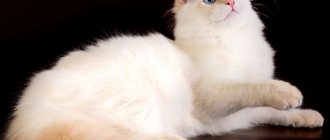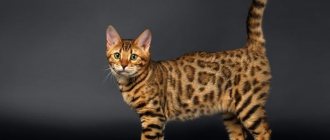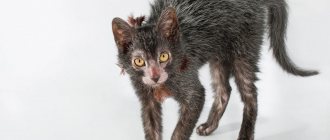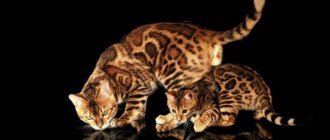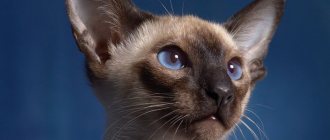Popular breeds
There are breeds whose representatives can only be gray, others allow a wide variety of colors, but it is the gray color that is considered one of the most expressive. Next, we invite you to consider photos and descriptions of the most popular gray cats.
- Russian blue. The birthplace of this breed is Russia and initially it existed only on the territory of this country. In the 18th century, blue cats were exported to England, and a little later they spread throughout Europe. According to the breed standard, such a pet can have only one color - noble blue. At the same time, the wool itself is very soft, dense and thick. The animal is characterized by a harmonious build, graceful gait and a very flexible tail. Gray cats of this breed are easy to breed and are distinguished by good health. However, they can only be bred within the breed.
- Siberian cat. For her, gray is not the only color, but it is in it that she looks the most original. The Siberian gray cat looks majestic, and in all possible variations of this shade. But the most incredible color among others is SOLID BLUE. In this case, the animal’s fur can have any shades of blue: from very light to dark. But the tone must be uniform on all parts of the body, and the nose and paw pads must be blue. Shading, when the ends of the hair are colored more intensely than the roots, is considered a defect.
- Scottish fold. These cats are known for their folded ears that do not extend beyond the contour of the head, making it appear even rounder, and the face is very cute. For fold-eared cats, gray coat color is also not the main color, but at the same time it is the most widespread. The color can be rich blue, warm lilac, lilac-gray, and silver-gray tabby is not uncommon. But if we talk specifically about the blue color, then it, like other breeds, must certainly be uniform. The paw pads and nose are blue-gray with a blue coat.
- British. It is believed that gray color is most typical for cats of the British breed. Their fur with this color shimmers with bluish colors and can be either very light or interspersed with dark gray hairs. Often there are blue-gray British cats whose fur is dyed as evenly as possible, making these cats look more like teddy bears than living pets. Eyes with a gray-blue coat can be either green or orange. And we all, of course, remember the famous gray tabby cat from the Whiskas advertisement. He also belongs to the British breed, and his color (merle tabby) is one of the most popular and sought after.
- Persians. The Persian gray cat can have either a uniform tone throughout its luxurious coat or its smoky variations, including blue ones. Moreover, representatives of this breed are called the only ones who can “try on” a huge range of gray tones. Among Persians, silver-marbled cats with a “butterfly” on their shoulders, and silver-lilac, and silver-blue, and silver-chocolate, etc. are common. The color of the eyes will depend on the color and can be green, honey and blue-green.
- Ojos azules. Absolutely all colors are allowed for representatives of this breed; the only thing undesirable is a large number of white spots. The calling card of such cats is their eye color – bright blue. Therefore, no other breed is capable of bringing into the world such a miracle as a gray cat with blue eyes.
Symbolism of color
In most world cultures, this color is considered a symbol of calm and peace.
Major religions view it differently:
- Christianity. All Christians are sure that the color of the sky induces humility and piety. The Virgin Mary is often depicted in a blue cloak, and Catholics present her with blue flowers. They symbolize purity, integrity and devotion to God.
- Buddhism. Here this shade is a symbol of motherhood, love and compassion for one’s neighbor. For them, it is associated with harmony, tranquility and spirituality.
- Judaism. All shades of this color symbolize holiness.
- Islam. For Muslims, this color is associated with mourning and sadness.
In ancient Rome, rich people painted blue veins on their arms and legs to emphasize their divine origin.
Christian clergy in colored robes.
Russian blue
What breeds of gray cats are there? The name of some speaks for itself. For example, when you hear “Russian blue cat,” you can roughly imagine what kind of purr it is. If you still don’t know her, then now let’s talk about this mustachioed one. This is an intelligent, gentle, attentive and devoted cat, with a beautiful quiet voice. She has a long tail, neck, elongated body. The color is blue (uniform) with a silver tint. At first, she is distrustful of new acquaintances. This cat does not like to change its habitat and prefers routine. She is affectionate and playful with her owners; unfortunately, she does not establish close relationships with owners very quickly. Over time, he becomes a devoted friend.
Did you like this breed of gray cat? You can see a photo of the representative in our article. You can take a closer look at its appearance.
Content
- 1 Cyan print and web colors are cyan and cyan. 1.1 Blue color
- 1.2 Internet color blue (sea green)
- 2.1 Aero blue
Breeds for which only gray coat color is acceptable
Among the varieties of cats, there are those that are characterized only by an ash-colored coat. These breeds include:
- ;
- chartreuse;
- Nibelung;
- korat
Russian blue
Representatives of this breed are medium in size and have a slender build. But the main feature of Russian blue cats is considered to be their unique color, emphasizing the bright green color of their eyes. Their coat has silver ticking, which gives their short, thick coat a snowy effect.
According to the standard, a Russian Blue cat must have uniform fur without yellowness, streaks or inclusions.
Chartreuse
These are large, well-built cats with well-developed muscles, a cheeky muzzle, a round head and small ears. Their soft, plush coat with a thick undercoat is colored only a uniform gray.
Blue cats' irises can be dark orange or bright yellow. And each chartreuse paw has soft gray-blue pads.
Nibelung
This is a long-haired variety of Russian Blue cats that has inherited all the characteristics of its ancestors with the exception of the structure and length of the fur. The Nibelungs got their name (translated from German as “creature of fog”) due to the unique color of their fur coat.
The thin silky coat of the breed is colored blue, in harmony with the green eyes. According to the standard, these gray cats have weak ticking.
Korat
These elegant gray cats were brought to Europe from northern Thailand over a hundred years ago and were long considered a cull of the Siamese. Korats are medium in size, flexible muscles and have an unusual heart-shaped head.
Best articles: Features of the Toyger breed
The hallmark of the breed is its olive-green eyes and short, silky coat, the color of which varies from blue-gray to lavender.
Using the color blue in healing meditations
This color helps in the treatment of various diseases. It refreshes well, relieves headaches, and reduces appetite, which is important for those who want to lose weight.
According to experts who practice color therapy, shades of this tone help reduce blood pressure, normalize sleep, and get rid of heartburn, diarrhea and vomiting.
For women, wearing this design reduces the amount of bleeding during menstruation and neutralizes PMS symptoms. It helps overcome shyness and self-consciousness.
Color healing has been used for a long time, dating back to the formation of Persia, Egypt and China. Each tone has its own effect on the body. Being in a room painted in blue tones helps fight thyroid diseases, activates sweating, lowers body temperature, which leads to the elimination of waste and toxins.
Caring for gray cats
Gray cats
, both blacks and tabbies are enviably healthy. They have strong immunity and are very cold-resistant. But there is one thing: color. Show cats have to limit themselves in many ways in order to shine with the ideal ash shade of their coat. Direct sunlight, excessive humidity, the presence of a large amount of iodine in food - all this leads to the appearance of yellowish spots on the coat, and as a result, underestimates the assessment of beauty according to breed standards.
A gray cat is not suitable for every owner. For example, children may find it boring and uninteresting. She is calm and balanced. You can't make her run for hours after a toy or jump from chair to chair. She has a special temperament and noble manners. The mysticism running through the history of its origin prophesies female happiness. Maybe a gray cat
can really give a strong family and love to those who really need it? As history has shown, on the “ashes” of her wool you still manage to build your own warm and cozy hearth, or at least place warmth in your heart.
Use in clothing
Regardless of the combinations used to design clothes, this shade gives the image romance, tenderness and naivety. If a woman wears a lot of blue, she is most often an idealist.
An accessory of this color is suitable for both business and evening style. A monochromatic outfit may look out of place.
For the “spring” color type, light and pure tones are suitable. Grayish shades are optimal for the “summer” and “autumn” color types. “Winter” should use azure and turquoise.
Blue in clothes.
How to care?
Caring for gray-white cats is not much different from caring for animals whose fur has other shades. However, there are still some characteristic features.
So, in the process of keeping an animal, as well as caring for it, one should take into account all the features of the breed that are characteristic of this animal
Particular attention should be paid to the behavioral patterns of cats.
In addition, as a general rule, when eating, you should avoid including animal products rich in iodine in your diet. The thing is that a high content of this component in the animal’s body can affect its appearance in such a way that the gray-white wool will have a brownish tint. If you want to preserve the original purity of the color, then this rule should in no case be neglected.
The diet must be saturated with all microelements and substances that are necessary for the full growth and development of the animal. It doesn’t matter whether you prefer dry food or natural food.
Due to the light color of the coat, grooming measures for it deserve special attention. Gray-white cats need bathing and hygiene procedures more often than other cats. This is especially true for those animals that spend a lot of time outside (for example, if you live in a private house and let your cat out into the yard). Combing procedures are also necessary, the regularity of which depends on the length of the fur of a particular animal.
Of course, to keep a cat at home, it must be provided with all the necessary equipment: a tray that acts as a toilet, its own bed, bowls of food and water, and a scratching post. Try to create the most comfortable and convenient conditions for the cat, because in your apartment he should feel at home, and not as a guest.
Despite the fact that all of the above aspects of cat care and maintenance are very important, the basic and basic principle of keeping a pet is still constant monitoring of its health. In order to maintain the animal's health at the proper level, from the very first day of keeping him, make sure that he has received all vaccinations and other necessary medical procedures. Do not forget about regular systematic visits to the veterinarian to treat the animal for fleas, worms and other harmful organisms.
Thus, you and I were able to see that in nature there are a huge number of species and breeds of gray-white cats. Some are more valuable and cost more than others. Despite this, there is no doubt that regardless of breed or lack thereof, the gray and white color attracts many
It is important to remember that the physiological and psychological characteristics of a particular animal will depend more on its breed, and not on its color. Therefore, before buying a pet, carefully study the characteristic features of cats of the exact type you plan to have at home.
About the Siberian breed of gray cats, see the video below.
Geography of blue - widespread use in home decoration
This color is often used when decorating houses, but it must be taken into account that its meaning varies in different countries. For example, in China this shade means immortality, in America it is associated with masculinity, in Japan - with deceit and meanness.
In Morocco, windows and doors are painted this color, because... it is believed to protect against evil spirits. This country is home to the bluest city on Earth - Chaven. Here, most of the houses are painted cobalt.
The positive influence of blue on a person’s psychological state is often used when decorating houses.
A siding roof of this color not only looks beautiful, but when people look at it, their blood pressure, breathing and muscle tone normalize. A house decorated in such colors is well suited for creative and romantic people.
When choosing this option, it is necessary to take into account that on a hot day, this design gives a feeling of coolness, but during the cold period it increases the feeling of chilliness, so you should not overdo it when using it.
Decorating a home in blue tones has the following advantages:
- visually strengthening the walls of the house, giving them grandeur and monumentality;
- reflection of sunlight, which is especially important in the southern regions;
- combination with bright and rich colors;
- slow fading in the sun, so the house retains its attractive appearance for a long time.
Description of the breed
Persian standard
There are currently 4 main types of Persian cats recognized:
- The classic type (British) is outdated, with a noticeable nose, the edge of which is located 5-6 mm below the edge of the inner corner of the eye.
- Modern type (short nose) - have an open look, the bridge of the nose is raised. Thanks to the wide eyes, the nasolacrimal ducts are not deformed, and the animal does not have a gloomy expression on its face.
- Extreme type (American) - the breed description is characterized by a short nose, round forehead, low-set ears, and straight-set eyes. The earlobe is almost at the same level with the inner corner of the eyes.
- Pig type (piggy) - the convexity of the skull is almost not pronounced, low weight, weak bones. This type is derived from the extreme.
Regardless of the type, the following reference characteristics are distinguished:
- Body: massive but compact; the chest and stomach are wide, rounded; the tail is proportionally short, very fluffy; average weight for females is 3-4 kg, for males 5-6 kg.
- Coat: silky, soft long hair covering the entire body; There are more than 200 species of Persian cat colors, including the graceful white Persian chinchilla.
- Head: muzzle flattened, almost flat, bone wide; forehead is rounded; the nose is short and raised.
- Eyes: wide-set, large and expressive; eye color can be green, blue, brown, and can also differ from one another (colorpoints with blue eyes and chinchillas with green should be noted separately); friendly look.
- Ears: usually small, low set, rounded tips; hidden behind abundant fur.
- Limbs: paws are fluffy, thick, proportionally short relative to the body.
- Life expectancy: extreme Persians live up to 15 years, ordinary modern Persians under normal conditions can live on average up to 20 years.
Best articles: The role of homologous chromosomes in cell division through mitosis and meiosis
Colors
- Solid (solid) - solid colors: white, black, blue, red (red), lilac, cream, chocolate. There are no patterns or streaks on the wool. Eye color is most often copper and dark orange or dark blue in white Persians.
- Bicolor is a combination of a primary color and white. The color of Persians is rare for Russian exhibitions, since breeding such a capricious spotted color requires a lot of effort. Bicolors should have at least 1/2 and no more than 2/3 white in color, with white spots on the head and tail desirable.
- Tabby - patterns on the fur: stripes, spots and marbles. Any basic coat color.
- Color point is the so-called Siamese coat color with dark spots on the face, paws and tail. Popular colors include brown, lilac, blue and black spots. Persian color-pointed cats were even identified as a separate breed - the Himalayan cat.
- Smoky is an amazing color in which each hair is conventionally divided into 2 color parts: a light base at the root and a dark color at the tip - tipping. At rest, the cat appears monochromatic, but when moving, the light undercoat becomes visible. Shades: black smoky, blue smoke, chocolate, tortoiseshell, lilac.
- Chinchilla - Golden and silver Persian chinchillas are now considered very popular and popular colors of the breed. Black tipping (the hair is colored only 1/8 with a dark tip) is evenly distributed on the back, sides, head and tail. The main color of gold is light apricot, while that of silver is pure white. A characteristic feature of chinchillas is the black rim around the eyes, nose and lips.
- Tortoiseshell is the color of Persian cats, in which there is a combination of two primary colors at once - red and black or their lightened analogues - cream and blue. This also includes the calico color - a combination of tortoiseshell and white.
Combination of blue with other colors and shades
When combined with other colors, you get gentle and inspiring solutions. This shade helps reveal dark colors better and allows you to create different combinations.
Pink
The result of this combination is warm, gentle and light tones. The expressive and rich palette includes white-lilac, raspberry, cloudy or sunset pink.
Orange
This combination is based on the contrast of blue and orange. Unlike blue, the sky shade softens this difference, so you get a harmonious and attractive composition, for example, peach, coral, tangerine, yellow or red-orange.
Red
This pair allows you to create seductive combinations. The contrast of warm and cold tones makes the heart beat faster. Against the background of blue, red looks bright and the darker it is, the higher the light contrast and the lower the thermal contrast. Resulting colors: garnet, ruby, wine, coral red.
A clear combination of red and blue.
Yellow and gold
These colors create a natural combination that is inspiring and energizing. It is possible to create the following shades: banana, apricot, amber, bright or yellow-gold.
Gray and silver
This is a classic variation. Against a gray background, blue dominates. To get a good result, you should use not pure gray, but its more complex tones. When decorating an interior, objects are most often painted gray, and trim is blue.
Green cold and warm
Paired with warm greens makes a joyful combination. These are related tones, so combining them allows you to create light and warm solutions. These include: brown-green, pistachio, chartreuse, marsh.
Cool green is more of a shade of blue. When combined, it is possible to create additional volume.
This palette is used independently and acts as a background for warm tones. The result is malachite, jade, emerald colors.
Blue
This solution makes it possible to obtain a monochromatic range, where blue acts as a highlight and blue as a shadow. The darker the colors combined, the brighter the contrast. Such solutions include cobalt, turquoise, electric, and Prussian blue.
Violet
When this color and purple are combined, a cool and mysterious range is obtained. The thermal contrast will be light and unobtrusive. The following compositions are created: grape, violet, amethyst, purple.
Beige and brown
Paired with brown makes a unique and attractive pairing. Warm earthy color and heavenly shade are two opposites, so they complement each other well. These are colors such as bronze, coffee, chocolate, mahogany.
Beige is a neutral color, which allows it to be combined harmoniously with blue. Beige in such a composition looks more feminine and graceful, it acquires a golden color.
White and black
Blue and white are the most popular combination. This color has a calming and relaxing effect, so it is often used in interior design.
The combination with black is bold and risky. It is appropriate for a strict business design or when designing evening sets.
The most delicate combination of white and blue.
Gray cat breeds
The elegant gray color of the cat's fur (aka blue) speaks volumes about the “breed” at first glance. These cats are nicknamed blue because of their unusual iridescence, which can sometimes be seen under direct light. Depending on the darkness of the color, blue and blue cats are distinguished. Since ancient times, the color blue has been associated with spirituality, wisdom and was endowed with special mystical properties. Therefore, cats with such an unusual color were also attributed the above qualities. Moreover, it was believed that a blue cat could predict bad weather and protect the family hearth from dark forces.
The subtle aesthetic of gray is also associated with the moon. This gives the animal a special mysticism and grace. Gray cats
recognized as one of the most elegant and aristocratic.
Many believe that the appearance of such an exquisite animal in the house will bring harmony to relationships and give the eyes pleasure from beauty. The moon symbolizes the feminine principle. Therefore, a gray cat will get along well with a representative of the fair sex and will have a beneficial effect on her nervous system and reproductive function. It was believed that a gray cat
could become a real guardian angel for a child in the womb.
The meaning of blue color in psychology
The ability to have a calming effect on the human body has led to the fact that this color is often used by psychotherapists when working with aggressive and hot-tempered patients. It is easily perceived, helps to relax, improves intuition.
For men
All heavenly shades are preferred by romantic men. Their mood may change frequently, and sometimes they are overly restless and fussy.
For women
Women who prefer this color are purposeful and selfless. They are always ready to defend their opinion.
If such colors predominate in a girl’s clothing, then it indicates her high spirituality, seriousness and ability to achieve her goals.
Being in a room painted in shades of blue helps a woman relax, calm down internally and extinguish unnecessary emotions.
For children
This color is associated with freshness and lightness, therefore it has a positive effect on the fragile child’s psyche and body. Such shades help the child calm down and relieve stress after a stormy day. Don't get too carried away, because... oversaturation with this tone leads to a feeling of coldness and alienation.
Nuances of care
A snow-white fur coat needs careful care:
- it is necessary to monitor the cleanliness of the house;
- brush and bathe your cat regularly, especially after walking outside;
- do not let the animal go for a walk in rainy weather;
- wash your eyes and clean your ear canals;
- change the filler in a timely manner;
- monitor nutrition - provide super-premium food;
- carry out deworming once every 3 months;
- treat for fleas and ticks twice a year;
Characteristic diseases
Snow cats are generally healthy, but heterochromia is common among individuals with heterochromia and blue eyes.
For example, Scottish fold cats suffer from pathologies of the cardiovascular system, have problems with the kidneys and teeth.
Persians have breathing problems due to the special structure of the skull and the curvature of the nasal septum. Animals suffer severely from renal failure, viral rhinotracheitis and hypertrophic cardiomyopathy.
Exotics are prone to conjunctivitis.
Orientals have digestive problems, suffer from bronchial asthma, heart pathologies, and strabismus.
Balinese dogs are diagnosed with congenital heart defects.
Why is deafness common among white cats?
In 1997, scientists conducted a study in which they were able to find out some facts about deafness in cats:
- Deafness can be complete or partial.
- Hearing loss is diagnosed in 20% of cats with a white coat and an iris of any color other than blue.
- 40% of all cats with heterochromia are deaf. Hearing loss is detected in the ear on the side of the blue eye.
In addition, scientists have explained the cause of hearing loss in cats. Responsibility was placed on the insidious mutant gene Dominant White (W-). At the stage of embryo formation, melanoblasts are formed in the area of the neural tube, which produce pigment and transport it to the retina. With normal embryo development, the pigment is delivered on time. These kittens are born with yellow or green eyes.
But as soon as the mutant gene gets involved, the speed of transport of melanoblasts decreases. The pigments do not have time to reach the skin and fill the follicles. The same thing happens with the retina - the pigment does not arrive. Sometimes a minimal number of melanoblasts reach their targets, so only some areas remain white. If the pigment fills the iris minimally, then kittens are born with heterochromia. One eye is blue, the other is yellow.
Scientists continue to study the effect of the gene on the body of cats, because snow-white individuals have a decrease in reproductive function and vitality.
Reference. Genetics have also identified factors that increase the likelihood of deafness - long hair and blue irises.
Albinism in cats
Albinos are also found among cats, just like other representatives of the animal world. From a scientific point of view, an albino cat is absolutely colorless, since the “ca” gene is present in its genetic makeup. It is he who is responsible for the lack of pigment in the color.
Pure albinos with red irises are rare. The most common are albinos with faded blue eyes. The “c” gene is responsible for the coloring of such special ones.
There are complete and partial albinism. In the case of complete disease, the body lacks the enzyme tyrosinase. This variety is observed in 1 case out of 10 thousand.
With partial albinism, the enzyme is present in small quantities, and the melanin produced is not able to color the entire body. In such individuals, most of the body remains white, and individual parts are painted in different colors.
Interesting. Often females, not males, are born full albinos.
How blue Bengals appear
The color gene responsible for the birth of a blue Bengal kitten is known as recessive. That is, it can be carried by any color, different types of patterns - a pair of Bengals without signs of blue in their fur may have smoky blue kittens. They will also recessively carry the “blue gene”, but it will not necessarily appear in the coming generations. However, in cases where a blue female is offered the same male for mating, the likelihood of the desired elite coloring in the offspring increases.
Breeders who have extensive experience working with blue Bengals have discovered an interesting pattern: when working with a recessive gene, other “non-major” genes often become dominant - for example, large spots, special softness of the coat, its shine. This is one of the reasons why Blue Bengals are quickly gaining popularity among professional breeders.
Unexpected results from the blue gene (blue is often considered a diluted color form of traditional brown shades) have given rise to a number of varieties. Experts already distinguish such types as spotted and marbled blue lynx, blue mink, blue sepia - spotted or marbled.
Features of white cats with blue eyes
White cats are active and inquisitive, they like to climb onto cabinets and examine household members or hide under the bed.
White cats are gentle and affectionate. They do not tolerate rudeness and cruelty. Animals love to be the center of attention and are able to detect the slightest changes in the owner’s intonation. Cats won't force themselves when they realize it's inappropriate.
Snow-white beauties prefer to sleep in the arms or next to the owner. They are quite smart and well trained. Owners of white cats note that their pets quickly become accustomed to the litter box and maintain the cleanliness of their luxurious coat on their own.
Kobe the cat
Genetics of this color
Three genes are responsible for the purity of white color:
If a female with the dominant white W gene is crossed with a cat of a different color, the kittens will repeat the color of the mother. The combination of two W genes produces variegated offspring. The iris of the eyes of such animals is bright blue or blue, topaz or green.
The S piebald gene is present in animals with white spots on the background of the main one. Visually, a cat is perceived as pure white if the spots merge. Eye color can be blue, yellow, green.
Advantages and disadvantages
Advantages of snow cats:
- peacefulness;
- friendliness;
- self-esteem;
- affectionate disposition;
- agreeableness;
- sensitivity.
Disadvantages: hearing loss and the need for careful grooming.
Cyan in print and web colors are cyan and cyan.
Blue
| Cyan (subtractive primary) | |
| Color coordinates | |
| Hexadecimal triplet | #00B7EB |
| sRGB B (, gram, ) | (0, 183, 235) |
| CMYK HOUR (, , , ) | (100, 22, 0,  |
| HSV (hour, , ) | (193°, 100%, 92[2]%) |
| Source | CMYK[3] |
| ISCC–NBS Descriptor | Brilliant greenish blue |
| B : Normalized to [0-255] (bytes) HOUR : Normalized to [0-100] (hundreds) | |
Cyan, magenta, and yellow are the three subtractive primary colors used in printing.
In color printing, the tint of cyan is called process cyan
or
pigment cyan
is one of the three primary pigment colors, which, along with yellow and magenta, make up the three subtractive primary pigment colors. (The secondary colors of the pigment are blue, green and red). The CMYK printing process was invented in the 1890s when newspapers began publishing color comics.
The cyan process is not an RGB color, and there is no fixed conversion of CMYK primary colors to RGB. Printer inks use different formulations, so there may be differences in the printing color, which is pure cyan ink. Typical formulation to process blue
displayed in the color box on the right. The source of the color shown on the right is the color magenta, which is shown in the chart located at the bottom of the following website that offers color books for CMYK printing: [1].
Internet color blue (cyan)
| Blue (optional secondary) | |
| Color coordinates | |
| Hexadecimal triplet | #00FFFF |
| sRGB B (, gram, ) | (0, 255, 255) |
| CMYK HOUR (, , , ) | (100, 0, 0, 0) |
| HSV (hour, , ) | (180°, 100%, 100%) |
| Source | X11 |
| ISCC–NBS Descriptor | Brilliant bluish green |
| B : Normalized to [0-255] (bytes) HOUR : Normalized to [0-100] (hundreds) | |
Red, green and blue lights representing the three basic additive primary colors of the RGB color system, red, green and blue.
Blue light is made up of equal amounts of green and blue light. Internet color blue
, shown at right, is one of the three secondary colors in the RGB color model, used to create all the colors on a computer or television screen by mixing different combinations of red, green, and blue light. The X11 name for this color is cyan; HTML name of the same color aqua. They are both made up of the same mixture of blue and green light and have the same color.
Agouti and non-agouti
The colors of cats are very diverse. Some cats are evenly colored - these are the so-called solid colors or solids . Other cats have a pronounced pattern - in the form of stripes, circles. This pattern is called tabby . Tabby "opens" on the coat thanks to the dominant gene A - agouti. This gene colors each cat's hair with evenly alternating dark and light transverse stripes.
In dark stripes, a larger amount of eumelanin pigment is concentrated, in light ones - less, and the pigment granules elongate, acquiring an ellipsoidal shape and are located sparsely along the length of the hair.
But if a homozygous allele (aa)—non-agouti—appears in the genotype of a black animal, the tabby pattern does not appear and the color turns out to be solid. This influence of some genes on other genes that are not allelic with them is called epistasis. That is, the allele (aa) has an epistatic effect on the tabby genes, it “covers” them, masks them, and prevents them from appearing. At the same time, the effect of allele (aa) does not extend to the O (orange) gene. Therefore, cats of red (cream) color always have an open tabby pattern, and the solid red color in cats is obtained through the breeder's breeding work, when selection is made for wider dark-colored stripes, the close proximity of which is perceived by the human eye as a solid red color.
Thus, all cats are tabbies, but not all are agoutis . Confirmation that all cats have a tabby in their genotype is the residual “ghost” baby tabby in many kittens. This residual tabby in cats of solid colors goes away, the cat sheds, the coat changes and becomes evenly colored.
